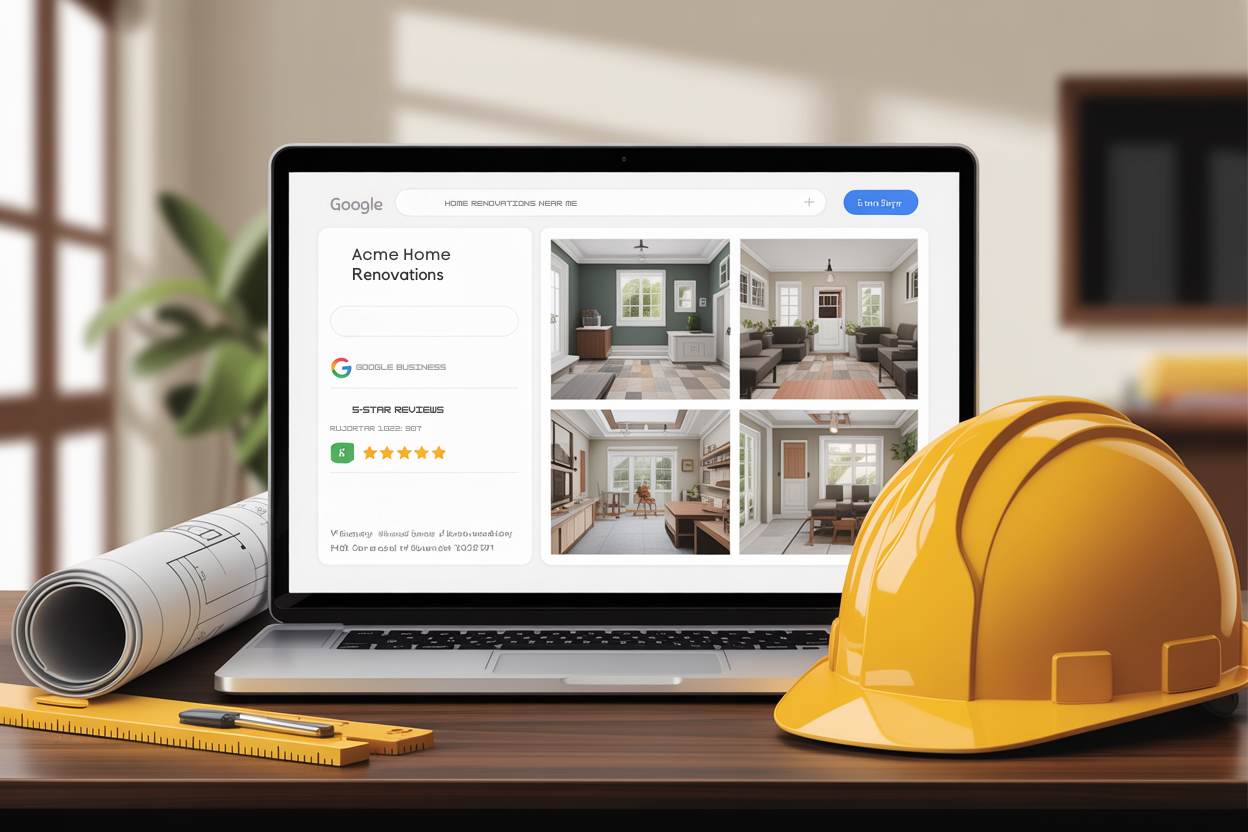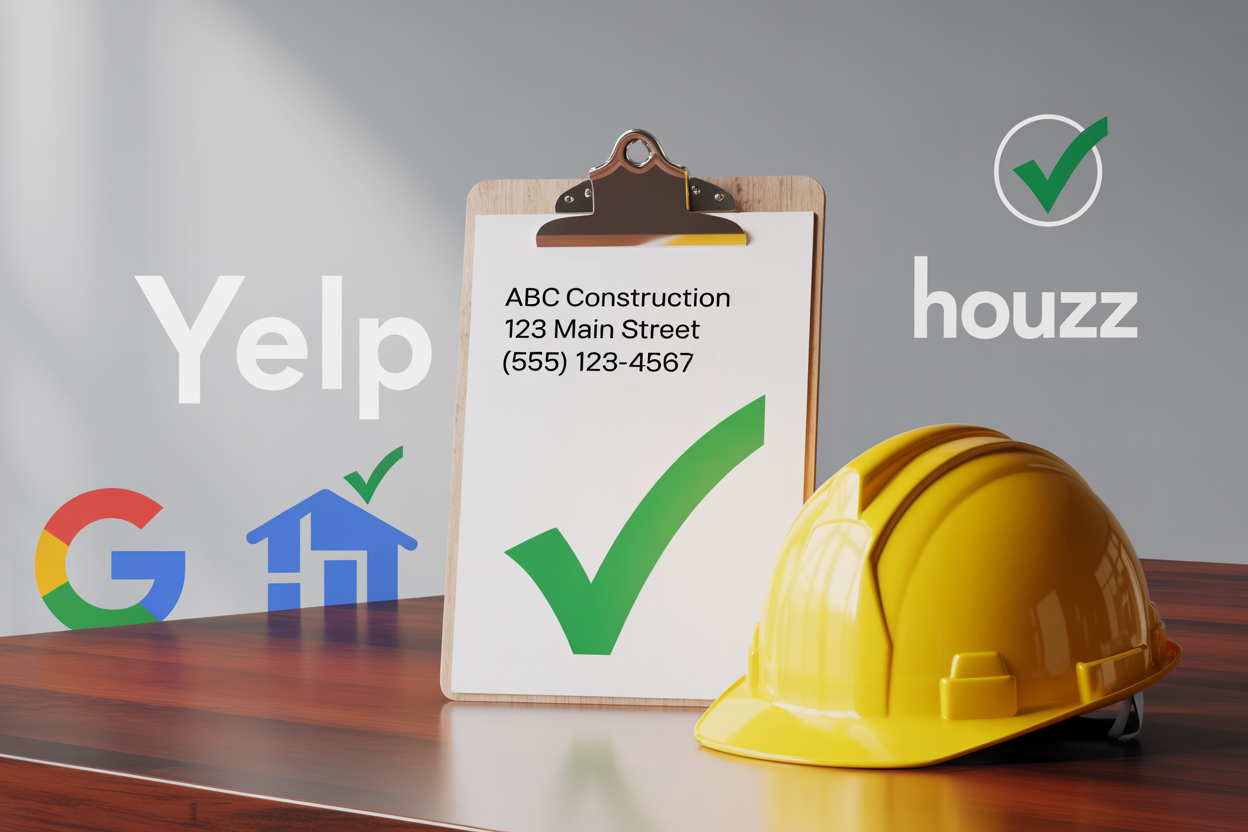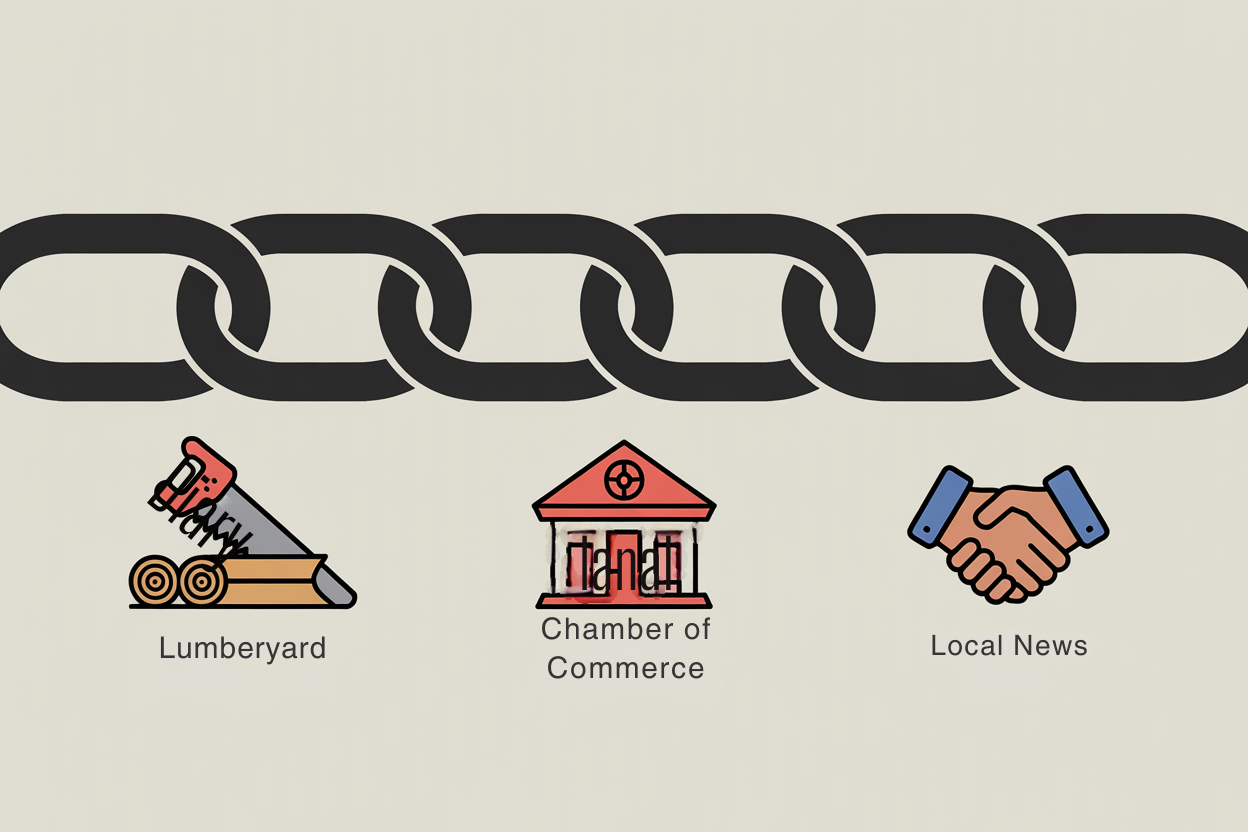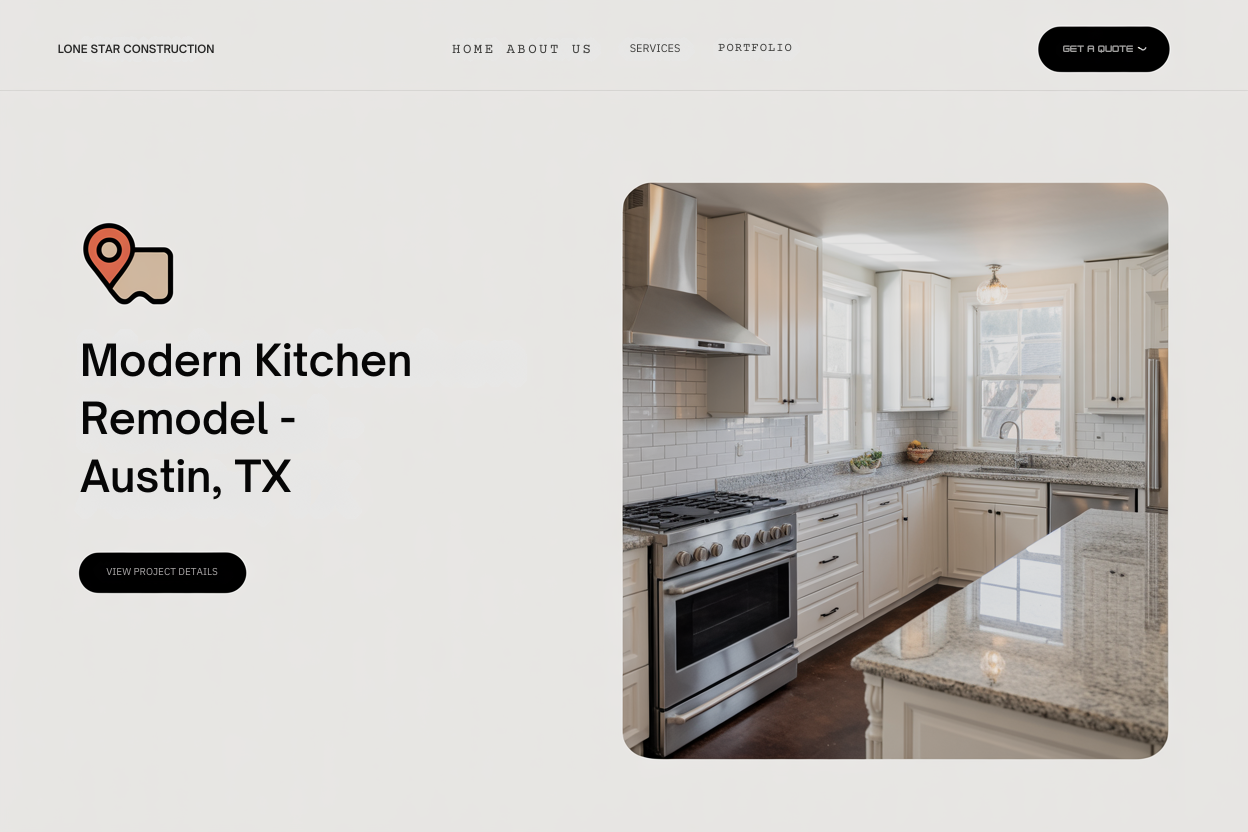How To Get Found on Google and Recommended by AI
Let’s be honest: if homeowners can’t find you online, you don’t exist. And in this business, being invisible means losing jobs to the contractor down the street who figured out how to show up on Google.
The good news? You don’t need a marketing degree or some SEO guru to dominate your local area. You just need a few smart tweaks, a little consistency, and a strategy built for contractors, not coffee shops or e-commerce brands.
This is exactly how general contractors can get found online with SEO.
1. Your Google Business Profile Is Your Digital Jobsite Sign

Your Google Business Profile (GBP) is the #1 tool that decides whether you get calls or crickets.
Think of it like your digital jobsite sign: clean it up, make it professional, and keep it updated. Here’s how to make Google love you:
- Fill out everything – services, hours, service areas, contractor license, the works. Don’t skip a single field.
- Show off your work – upload before-and-after photos, finished projects, team shots, and even videos.
- Post updates weekly – showcase new builds, remodeling tips, or recent projects. Google rewards activity.
- Collect reviews like they’re 2x4s – the more you have, the stronger your profile.
- Reply to every review – good or bad. Homeowners trust responsive contractors.
Pro Tip: Include phrases like “custom kitchen remodel in [Your City]” in your business description. It’s a subtle SEO boost without sounding spammy.
2. Pick the Right Local Keywords (Not Guesswork)

One of the biggest Contractor SEO slip-ups contractors make is speaking in contractor language instead of homeowner language.You might know the right term is “structural beam replacement” or “load-bearing wall modification.” But guess what? No homeowner is typing that into Google at midnight while dreaming about their open-concept kitchen.
They’re searching things like:
- “knock down wall to open kitchen [your city]”
- “kitchen remodel near me”
- “best general contractor in [neighborhood in your city]”
- “bathroom remodel cost Houston”
See the difference? One is technical, the other is practical. Homeowners search based on their problems and goals, not your trade terminology.
How to find the right keywords:
- Use free tools. Google’s Keyword Planner, Ubersuggest, or even typing your service into Google and checking the “People Also Ask” section can give you real search phrases.
- Spy on competitors. Look at what local competitors are ranking for. If their site shows up for “patio cover contractor Austin,” you know that phrase is worth targeting.
- Ask your clients. The simplest method: when you land a new client, ask them what they searched before finding you. Their answers are pure gold for your keyword list.
- Mix city + service. Always pair your service with the location. Example: “kitchen remodeling Dripping Springs”or “garage conversion Austin TX.” Google eats this up for local results.
- Don’t forget neighborhoods. In cities like Austin, people often search by subdivision or community name: “Circle C bathroom remodel” or “Steiner Ranch kitchen renovation.” If you’ve done work there, you should target it.
Pro Tip: Build a list of 10–15 “money keywords” (the ones most likely to bring you jobs) and weave them into your website, project pages, and blog posts. You don’t need hundreds, just the right handful that match what homeowners are actually searching.
The takeaway? SEO for contractors isn’t about showing off technical vocabulary. It’s about meeting homeowners where they are, in the exact words they use, so Google can connect their search with your services.
3. Consistency Wins: Master Your NAP

Think of your Name, Address, and Phone number (NAP) as your company’s digital fingerprint. If that fingerprint doesn’t match across the web, Google isn’t sure who you are or if you’re even legit. And when Google’s confused, it’s your phone that stops ringing.
For example, if you’re listed as “Jones Construction LLC” on Yelp but “Jones Contracting” on Houzz, Google treats them like two different businesses. Same goes for mismatched addresses (Suite vs. Ste.), outdated phone numbers, or missing business names.
Why it matters: Google’s Local Search algorithm is built on trust and consistency. The more uniform your business information appears, the more confident Google is in showing you to homeowners searching for contractors near them.
Where to focus first: Start by claiming, verifying, and cleaning up these profiles:
- Google Business Profile – Non-negotiable. This is the #1 listing that fuels local search results and “near me” maps. Here’s how to optimize your profile.
- Yelp – Still heavily used by homeowners and often surfaces in Google results.
- Angi / HomeAdvisor – Love them or hate them, homeowners check here.
- Houzz – Especially strong for remodels, design-heavy projects, and photo-driven work.
- Better Business Bureau (BBB) – Adds trust and credibility, especially for bigger-ticket jobs.
- Local Chamber of Commerce directories – Often overlooked, but these links carry serious local SEO weight.
How to clean it up:
- Audit your NAP. Search your business name + phone number and see how you’re listed across the web.
- Fix mismatches. Update any outdated or inconsistent profiles immediately.
- Use one format and stick to it. Decide if you’re “Jones Construction LLC” or “Jones Contracting,” then never deviate. Same with addresses: if it’s 123 Main St., Ste 200, use that exact version everywhere.
- Keep track in a spreadsheet. This helps you (or your team) maintain consistency over time, especially if you add new directories later.
Pro Tip: Don’t forget “secondary” listings. Facebook, Instagram business pages, Nextdoor, and even industry supplier directories often display your NAP. Google picks those up too, long story short, so they need to be consistent.
The bottom line: mastering your NAP may not sound sexy, but it’s one of the easiest ways to build trust with both Google and homeowners. And unlike ads, once it’s fixed, it works for you 24/7.
4. Reviews = Referrals in 2024

For contractors, reviews aren’t “nice to have”...they’re deal-breakers.
Homeowners read reviews like blueprints before hiring. Here’s how to stack the deck:
- Ask right after delivery, pretty much as soon as a project wraps and the homeowner’s thrilled, strike while the paint’s drying.
- Make it easy, text or email a direct review link. Don’t make them hunt for it.
- Leverage video testimonials, even a 20-second phone video can set you apart from competitors.
- Respond to the negative reviews, calmly and professionally. Future clients are watching how you handle criticism.
Here’s how to ask for reviews, complete with templates and examples.
5. Build Local Backlinks Like a Pro

Backlinks are simply links from other sites pointing to yours and Google eats them up like free tacos at a jobsite lunch. But not all backlinks are equal. For contractors, the most powerful ones are local because they prove to Google that you’re a trusted, established business in your community. Here are smart ways to make it happen:
1. Get featured in local media.
Pitch your projects to neighborhood papers, lifestyle blogs, or TV stations. A story like “Local Contractor Restores Historic Downtown Home” or “GC Helps Family Rebuild After Storm” earns you credibility, free PR, and a high-authority backlink that search engines love.
2. Partner with suppliers and vendors.
Every lumberyard, countertop shop, or flooring supplier has a website. Ask them to list you as a preferred contractor and link to your portfolio. It’s a win-win: they look good recommending quality pros, and you get a backlink that builds trust with both customers and Google.
3. Join associations and directories.
Industry groups like the National Association of Home Builders (NAHB), your local Chamber of Commerce, or remodeler’s guilds almost always include a directory listing with a backlink. These are gold because they signal legitimacy and authority in your trade.
4. Sponsor local events.
Whether it’s a youth sports team, a charity 5K, or a home show, most sponsorships come with a website link back to your business. Not only are you boosting SEO, but you’re also putting your name in front of real homeowners in your community.
5. Leverage satisfied clients.
If your client owns a business, ask if they’ll give you a shout-out (and backlink) on their website or blog. A testimonial or “thanks to our contractor” post carries extra weight because it’s authentic and rooted in the local market.
6. Don’t forget niche sites.
Houzz, Angi, Yelp, Nextdoor, and even local Facebook groups allow you to create profiles with backlinks. While some are “nofollow” links, they still help with visibility and send traffic that often converts into real leads.
Backlinks for contractors aren’t about chasing giant national sites. They’re about weaving your business into the online fabric of your local community. Each link is like a digital referral and Google notices.
6. Use Project Pages to Dominate “Near Me” Searches

Most contractors lump all their photos into one giant gallery page, but that’s a big missed opportunity for local SEO. Instead, create dedicated project pages for each job. Think of them as mini case studies that do double duty: they showcase your craftsmanship and help you rank higher in “near me” searches.
Here’s how to structure them for maximum impact:
1. Showcase high-quality project photos.
Before-and-after shots, wide-angle views, and close-ups of finishes all help homeowners visualize what you can do. Bonus: Google loves original images and may even show them in local search results.
2. Write a short but detailed project description.
Include the type of project, what problems the homeowner had, and how you solved them. Example: “The homeowners wanted a modern, open-concept kitchen that blended with their rustic-style home. We removed two walls, installed custom shaker cabinets, and added quartz countertops with a waterfall edge.”
3. Include the neighborhood or city name.
Mentioning the location (e.g., “Circle C Ranch in Austin, TX” or “Bee Cave Master Bath Remodel”) helps you show up when people search “kitchen remodel Circle C” or “bathroom renovation near Bee Cave.” This hyper-local targeting is SEO gold.
4. Highlight the services performed.
List out the specific trades or services: framing, electrical, plumbing, tile, painting, etc. That way, you’re not just ranking for “kitchen remodel” you’re also showing up for “custom tile installation Austin” or “home addition contractor Bee Cave.”
5. Add credibility boosters.
Include client testimonials, a short video walkthrough, or even the project timeline. These details build trust and show potential clients you’ve done quality work right in their backyard.
6. Optimize for conversion.
Every project page should have a clear call-to-action: “Like what you see? Schedule your free estimate today.” Add a simple contact form or phone number at the bottom so homeowners don’t have to hunt for it.
Example page title:
- “Modern Kitchen Remodel in Circle C Ranch In Austin, TX”
- “Outdoor Living Space with Custom Pergola in Dripping Springs, TX”
- “Luxury Bathroom Renovation in Bee Cave (Hill Country Modern Style)”
With 10–20 well-built project pages, you’ll start showing up for dozens of neighborhood-level searches. And when homeowners see you’ve completed projects right where they live, they’ll instantly trust you more than the contractor who just has a generic photo gallery.
7. Post Like a Pro (and Outsmart Your Competition)

Homeowners are tired of vague promises. They want to see what you can do and hear how you do it. This is where your website, blog, and social media pull double duty: marketing tools for leads and trust-building platforms that set you apart from the competition.
Here’s how to make your posts work harder for you:
1. Showcase progress photos and not just the polished “after” shots.
Take people behind the scenes. Post demo day highlights, framing shots, tile going in, or custom cabinets being installed. These photos prove you’re active, reliable, and capable of delivering results from start to finish.
2. Share quick remodeling tips.
Simple tips like “3 ways to stretch your kitchen remodel budget” or “Best paint finishes for high-traffic areas” build trust. You don’t have to give away your trade secrets, just enough value to show you know your stuff.
3. Answer local FAQs.
Write blog posts or short videos around questions you get all the time, like:
- “How much does a kitchen remodel cost in Austin, TX?”
- “What’s the average timeline for a bathroom renovation in Dripping Springs?”
- “Do I need permits for a home addition in Bee Cave?”
Answering these makes you the go-to contractor when homeowners are Googling at midnight.
4. Call out common homeowner mistakes.
Posts like “5 Costly Mistakes Homeowners Make During Remodels” or “Why Skipping Permits Can Cost You Big”educate your audience and position you as the trusted expert who helps them avoid headaches.
5. Mix authority with personality.
Don’t be afraid to show your crew on-site, celebrate a project wrap-up, or share why you love working in a certain neighborhood. People don’t just hire contractors, they hire people they trust.
6. Be consistent.
Posting once every six months won’t cut it. Create a simple rhythm: one blog post per month, weekly Instagram updates, and project highlights on Facebook. Consistency builds both SEO momentum and credibility with homeowners.
Pro Tip: Repurpose your content. A blog post answering “How much does a kitchen remodel cost in Austin?” can be turned into a Facebook post, a quick TikTok video, an Instagram carousel, and even an FAQ page on your website. One idea → five platforms → maximum impact.
Check out these 5 Facebook Ad Ideas To Get More Home Remodeling Leads
The more you post, the more Google sees you as an authority and the more homeowners see you as the contractor who actually knows what they’re talking about. That combination is hard to beat.
8. Bonus Power Moves for Contractors

If you want to really leave your competitors in the dust:
- Geo-tag your photos before uploading them to your Google Business Profile.
- Use schema markup so search engines understand you’re a contractor.
- Run Google Local Service Ads to get those “Google Guaranteed” badges — they convert like crazy.
Get Discovered in AI Search (The New Front Door)
Here’s the shift nobody’s talking about: AI tools are becoming the first stop for homeowners. If you want ChatGPT or Gemini to recommend you by name, you need to give them data they trust.
Here’s how: Publish Authoritative Local Content
AI tools scrape trusted websites when recommending contractors. Create content that answers the exact questions homeowners are asking:
- “How much does a kitchen remodel cost in Austin?”
- “Best general contractor in Bee Cave”
- “How to plan a whole-home renovation”
Add location-specific project pages and blog posts on your site so AI can find and rank you.
The Bottom Line When It Comes To Local SEO For General Contractors
Local SEO isn’t about hacking algorithms. It’s about showing up where homeowners are looking and proving you’re the right contractor for the job.
Do the basics consistently, like keep your Google profile active, collect reviews, create location-targeted content and you’ll stay ahead of 90% of contractors in your area.
Remember: homeowners are searching for you right now. The only question is…will they find you or the guy down the street?















